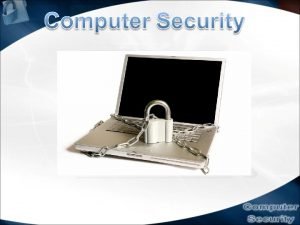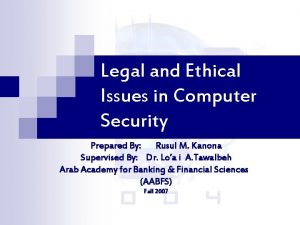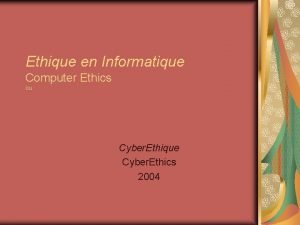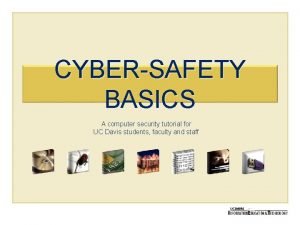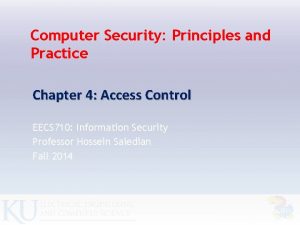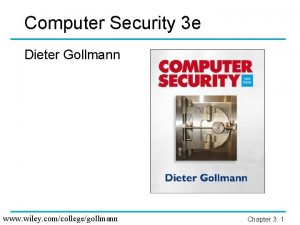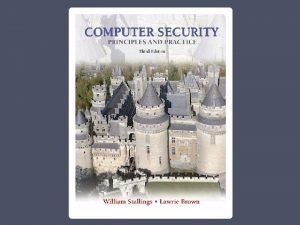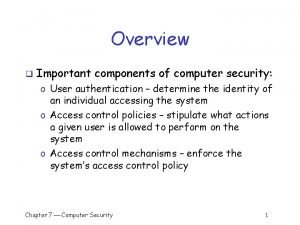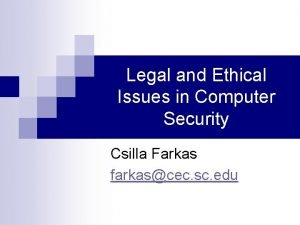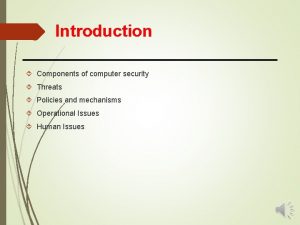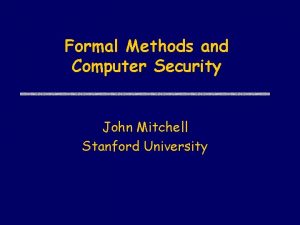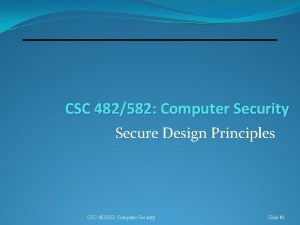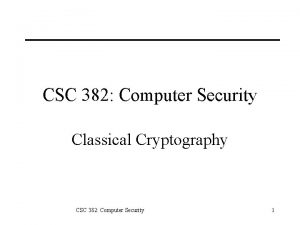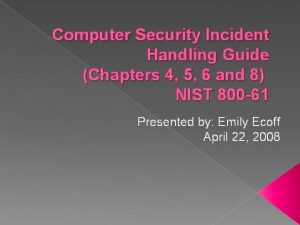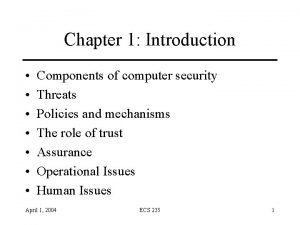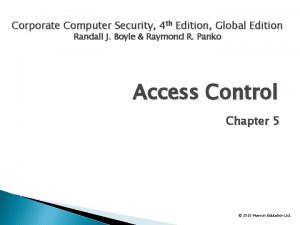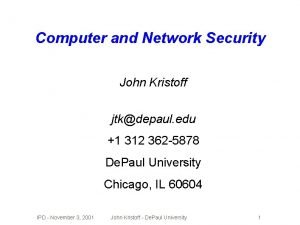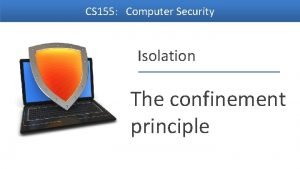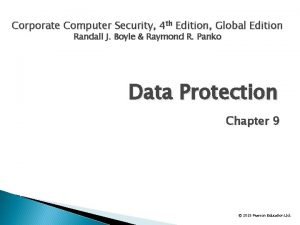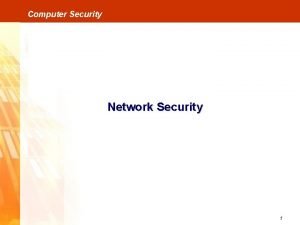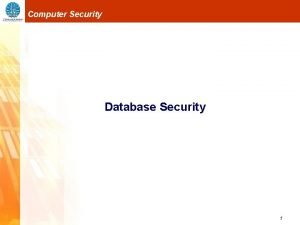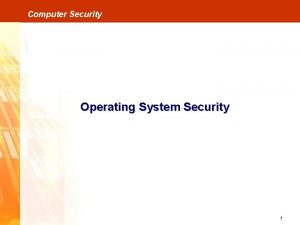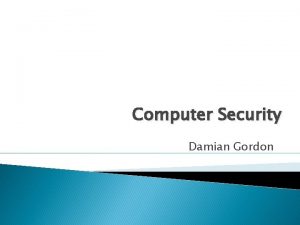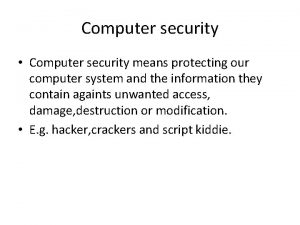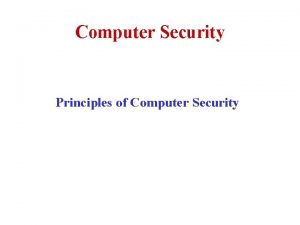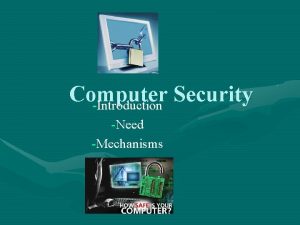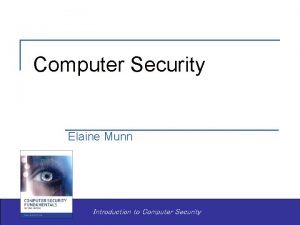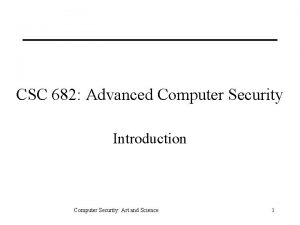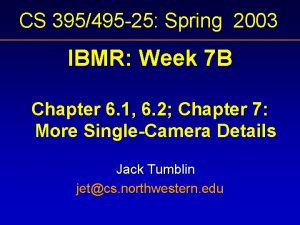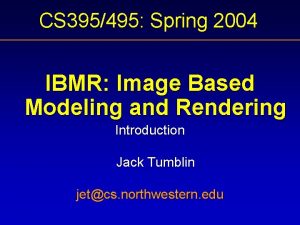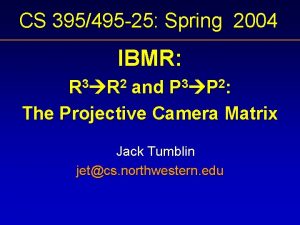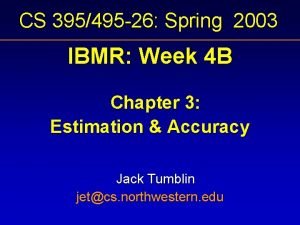Welcome to CS 395495 Introduction to Computer Security









































- Slides: 41

Welcome to CS 395/495 Introduction to Computer Security

Why Computer Security • The past decade has seen an explosion in the concern for the security of information – Malicious codes (viruses, worms, etc. ) caused over $28 billion in economic losses in 2003, and will grow to over $75 billion by 2007 • Jobs and salaries for technology professionals have lessened in recent years. BUT … • Security specialists markets are expanding ! – “ Full-time information security professionals will rise almost 14% per year around the world, going past 2. 1 million in 2008” (IDC report)

Why Computer Security (cont’d) • Internet attacks are increasing in frequency, severity and sophistication • Denial of service (Do. S) attacks – Cost $1. 2 billion in 2000 – 1999 CSI/FBI survey 32% of respondents detected Do. S attacks directed to their systems – Thousands of attacks per week in 2001 – Yahoo, Amazon, e. Bay, Microsoft, White House, etc. , attacked

Why Computer Security (cont’d) • Virus and worms faster and powerful – Melissa, Nimda, Code Red II, Slammer … – Cause over $28 billion in economic losses in 2003, growing to over $75 billion in economic losses by 2007. – Code Red (2001): 13 hours infected >360 K machines $2. 4 billion loss – Slammer (2003): 10 minutes infected > 75 K machines $1 billion loss

Overview • Course Administrative Trivia • What is security: history and definition • Security policy, mechanisms and services • Security models

Logistics • Instructor Yan Chen (ychen@cs. northwestern. edu), Office Hours: Wed. 3: 30 -5: 30 pm or by appointment, Rm 330, 1890 Maple Ave. • TA Zhichun Li (lizc@cs. northwestern. edu) Office Hours: Mon. 3: 30 -4: 30 pm, Fri. 10: 3011: 30, Rm 321, Maple Ave.

Course Overview • Instructional class, will be CS 350 next year • Satisfy the project course requirement for undergrads • Satisfy the breadth requirement for system Ph. D. students • Different from CS 450 “Internet Security” seminar course

Course Objective • Understand the basic principles for information and communication security, and be able to apply these principles to evaluate and criticize information system security properties • Be able to use some important and popular security tools, like encryption, digital signatures, firewalls, intrusion detection systems (IDS) • Be able to identify the vulnerability of the Internet systems and recognize the mechanisms of the attacks, and apply them to design and evaluate counter-measure tools

Course Contents • • • Cryptography – Secret key algorithms: DES/AES – Public key algorithms: RSA – One-way hash functions & message digests: MD 5, SHA 2 Software security – Buffer overflow, heap overflow and string format bugs – Detection techniques: static program analysis vs. runtime detection Operating system security techniques – Dealing with bad (legacy) codes: sandboxing – Multi-level security, file system security

Course Contents (cont’d) • Authentication, access control, public key infrastructure (PKI, briefly) – • • • Case study: Kerberos Internet vulnerability – Denial-of-service attacks – viruses, worms, Trojan horses Securing the Internet – Intrusion detection systems (IDSs): host- vs. network- based, signature vs. statistical detection – Case study: Snort and Bro – Firewalls, VPN and IPsec Web and wireless network security (SSL/TLS)

Prerequisites and Course Materials • Required: CS 343 (Intro to operating systems) • Highly Recommended: networking or having some familiarity with Unix systems programming • Required textbooks (see webpage for other recommendation) – Network Security - Private Communication in a Public World, by Charlie Kaufman, Radia Perlman and Mike Speciner, 2 nd Edition, Prentice Hall, 2002 – Cryptography and Network Security, by William Stallings, 3 rd Edition, Prentice Hall, 2003

Grading • Class participation 10% • Homework 10% • Project 40% – Using of cryptography software (PGP) - 5% – Buffer/string overflow exploit - 15% – Intrusion detection systems/firewalls – 20% • Midterm 20% • Final 20% – Exams in-class, closed-book, non-cumulative • Late policy: 10% each day after the due date • No cheating

Communication • Slides will be made online prior to each class • Web page: http: //www. cs. northwestern. edu/~ychen/classe s/cs 395/ • Newsgroup (cs. compsec) will be available • Send emails to instructor and TA for questions inappropriate in newsgroup

Projects • Need to apply for T-Lab account if you don’t have one currently • Some familiarity with Unix systems programming needed, preferably in C or C++ – Project 2 needs a little bit knowledge on X 86 assembly language, but should be easy to pick up • We will hold a competition for statistical IDS of project 3. The winners will earn extra bonus points plus some real gift awards • Project 1 and 2 are individual, project 3 for a team of two to three

Research on Computer Security • Lab for Internet and Security Technology (LIST) • Http: //list. cs. northwestern. edu • Hire students for Internet security research – Sponsored by Microsoft Research and Northwestern Murphy Society

Overview • Course Administrative Trivia • What is security: history and definition • Security policy, mechanisms and services • Security models

The History of Computing • For a long time, security was largely ignored in the community – The computer industry was in “survival mode”, struggling to overcome technological and economic hurdles – As a result, a lot of comers were cut and many compromises made – There was lots of theory, and even examples of systems built with very good security, but were largely ignored or unsuccessful • E. g. , ADA language vs. C (powerful and easy to use)

Computing Today is Very Different • Computers today are far from “survival mode” – Performance is abundant and the cost is very cheap – As a result, computers now ubiquitous at every facet of society • Internet – Computers are all connected and interdependent – This codependency magnifies the effects of any failures

Biological Analogy • Computing today is very homogeneous. – A single architecture and a handful of OS dominates • In biology, homogeneous populations are in danger – A single disease or virus can wipe them out overnight because they all share the same weakness – The disease only needs a vector to travel among hosts • Computers are like the animals, the Internet provides the vector. – It is like having only one kind of cow in the world, and having them drink from one single pool of water!

The Warhol Worm • A properly designed worm can infect every vulnerable host on the Internet within 15 minutes – “How to own the Internet in your spare time” (Staniford, Paxon and Weaver, Usenix Security 2002) – Exploit many vectors such as P 2 P file sharing, intelligent scanning, hitlists, etc. – Referred to as Warhol worm after Andy Warhol’s quote “In the future, everyone will have 15 minutes of fame”

The Definition of Computer Security • Security is a state of well-being of information and infrastructures in which the possibility of successful yet undetected theft, tampering, and disruption of information and services is kept low or tolerable • Security rests on confidentiality, authenticity, integrity, and availability

The Basic Components • Confidentiality is the concealment of information or resources. – E. g. , only sender, intended receiver should “understand” message contents • Authenticity is the identification and assurance of the origin of information. • Integrity refers to the trustworthiness of data or resources in terms of preventing improper and unauthorized changes. • Availability refers to the ability to use the information or resource desired.

Security Threats and Attacks • A threat is a potential violation of security. – Flaws in design, implementation, and operation. • An attack is any action that violates security. – Active adversary • An attack has an implicit concept of “intent” – Router mis-configuration or server crash can also cause loss of availability, but they are not attacks

Friends and enemies: Alice, Bob, Trudy • well-known in network security world • Bob, Alice (lovers!) want to communicate “securely” • Trudy (intruder) may intercept, delete, add messages Alice data channel secure sender Bob data, control messages secure receiver Trudy data

Eavesdropping - Message Interception (Attack on Confidentiality) • Unauthorized access to information • Packet sniffers and wiretappers • Illicit copying of files and programs B A Eavesdropper

Integrity Attack - Tampering With Messages • Stop the flow of the message • Delay and optionally modify the message • Release the message again B A Perpetrator

Authenticity Attack - Fabrication • Unauthorized assumption of other’s identity • Generate and distribute objects under this identity A B Masquerader: from A

Attack on Availability • Destroy hardware (cutting fiber) or software • Modify software in a subtle way (alias commands) • Corrupt packets in transit A • Blatant denial of service (Do. S): – Crashing the server – Overwhelm the server (use up its resource) B

Classify Security Attacks as • Passive attacks - eavesdropping on, or monitoring of, transmissions to: – obtain message contents, or – monitor traffic flows • Active attacks – modification of data stream to: – masquerade of one entity as some other – replay previous messages – modify messages in transit – denial of service

Overview • Course Administrative Trivia • What is security: history and definition • Security policy, mechanisms and services • Security models

Security Policy and Mechanism • Policy: a statement of what is, and is not allowed. • Mechanism: a procedure, tool, or method of enforcing a policy. • Security mechanisms implement functions that help prevent, detect, and respond to recovery from security attacks. • Security functions are typically made available to users as a set of security services through APIs or integrated interfaces. • Cryptography underlies many security mechanisms.

OSI Security Architecture • ITU-T X. 800 Security Architecture for OSI • Defines a systematic way of defining and providing security requirements • For us it provides a useful, if abstract, overview of concepts we will study • X. 800 defines security services in 5 major categories

Security Services (X. 800) • Authentication - assurance that the communicating entity is the one claimed • Access Control - prevention of the unauthorized use of a resource • Data Confidentiality –protection of data from unauthorized disclosure • Data Integrity - assurance that data received is as sent by an authorized entity • Non-Repudiation - protection against denial by one of the parties in a communication

Security Mechanisms (X. 800) • Specific security mechanisms: – Encipherment – Digital signatures – Access controls – Data integrity – Authentication exchange – Traffic padding – Routing control – Notarization • Pervasive security mechanisms: – Trusted functionality – Security labels – Event detection – Security audit trails – Security recovery

Overview • Course Administrative Trivia • What is security: history and definition • Security policy, mechanisms and services • Security models

Model for Network Security

Model for Network Security • Using this model requires us to: – Design a suitable algorithm for the security transformation – Generate the secret information (keys) used by the algorithm – Develop methods to distribute and share the secret information – Specify a protocol enabling the principals to use the transformation and secret information for a security service

Model for Network Access Security

Model for Network Access Security • Using this model requires us to: – Select appropriate gatekeeper functions to identify users – Implement security controls to ensure only authorised users access designated information or resources • Trusted computer systems can be used to implement this model

How to Make a System Trustworthy • Specification – A statement of desired functions • Design – A translation of specifications to a set of components • Implementation – Realization of a system that satisfies the design • Assurance – The process to insure that the above steps are carried out correctly – Inspections, proofs, testing, etc.

The Security Life Cycle • The iterations of – Threats – Policy – Specification – Design – Implementation – Operation and maintenance
 395495
395495 Private secuirty
Private secuirty Welcome welcome this is our christmas story
Welcome welcome this is our christmas story The osi security architecture
The osi security architecture Security guide to network security fundamentals
Security guide to network security fundamentals Wireless security in cryptography
Wireless security in cryptography Visa international security model in information security
Visa international security model in information security Electronic mail security in network security
Electronic mail security in network security Nstissc security model in information security
Nstissc security model in information security E commerce security meaning
E commerce security meaning Software security building security in
Software security building security in Security guide to network security fundamentals
Security guide to network security fundamentals Security guide to network security fundamentals
Security guide to network security fundamentals Welcome
Welcome Welcome prayer introduction
Welcome prayer introduction Basic components of security
Basic components of security Legal, social, ethical and professional issues in computing
Legal, social, ethical and professional issues in computing Legal and ethical issues in computer security
Legal and ethical issues in computer security Ethique informatique
Ethique informatique Computer security tutorial
Computer security tutorial Computer security 161 cryptocurrency lecture
Computer security 161 cryptocurrency lecture Computer security principles and practice
Computer security principles and practice Computer security principles and practice solutions
Computer security principles and practice solutions Computer security dieter gollmann
Computer security dieter gollmann Nist computer security handbook
Nist computer security handbook Portcullis security
Portcullis security Components of computer security
Components of computer security Attack sophistication vs intruder technical knowledge
Attack sophistication vs intruder technical knowledge Computer security attack
Computer security attack Https://www.naturalnews.com wikipedia
Https://www.naturalnews.com wikipedia Stanford computer security
Stanford computer security Csci235
Csci235 Fail-safe defaults example
Fail-safe defaults example Computer security
Computer security Computer security incident handling guide
Computer security incident handling guide Components of computer security
Components of computer security Corporate computer security
Corporate computer security Basic components of computer security
Basic components of computer security Computer & network security
Computer & network security Computer security fundamentals 4th edition
Computer security fundamentals 4th edition Confinement principle in computer system security
Confinement principle in computer system security Corporate computer security
Corporate computer security















